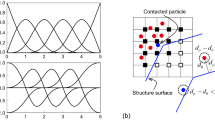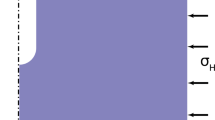Abstract
During the operation of nuclear waste disposal facilities, some sprayed concrete reinforced underground spaces will be in use for approximately 100 years. During this time of use, the local stress regime will be altered by the radioactive decay heat. The change in the stress state will impose high demands on sprayed concrete, as it may suffer stress damage or lose its adhesion to the rock surface. It is also unclear what kind of support pressure the sprayed concrete layer will apply to the rock. To investigate this, an in situ experiment is planned in the ONKALO underground rock characterization facility at Olkiluoto, Finland. A vertical experimental hole will be concreted, and the surrounding rock mass will be instrumented with heat sources, in order to simulate an increase in the surrounding stress field. The experiment is instrumented with an acoustic emission system for the observation of rock failure and temperature, as well as strain gauges to observe the thermo-mechanical interactive behaviour of the concrete and rock at several levels, in both rock and concrete. A thermo-mechanical fracture mechanics study is necessary for the prediction of the damage before the experiment, in order to plan the experiment and instrumentation, and for generating a proper prediction/outcome study due to the special nature of the in situ experiment. The prediction of acoustic emission patterns is made by Fracod 2D and the model later compared to the actual observed acoustic emissions. The fracture mechanics model will be compared to a COMSOL Multiphysics 3D model to study the geometrical effects along the hole axis.


















Similar content being viewed by others
References
Davies J (1988) Numerical study of punch-through shear specimen in mode II testing for cementitious materials. Int J Cem Compos Lightweight Concr 10(1):3–14
Detournay E, St. John CM (1988) Design charts for a deep circular tunnel under non-uniform loading. Rock Mech Rock Eng 21(2):119–137
EN 1992-1-1 (2004) Eurocode 2: design of concrete structures. Part 1-1: general rules and rules for buildings. Finnish Standards Association, SFS, Helsinki, Finland
Glamheden R, Fälth B, Jacobsson L, Harrström J, Berglund J, Bergkvist L (2010) Counterforce applied to prevent spalling. SKB technical report TR-10-37. Swedish Nuclear Fuel and Waste Management Co., Stockholm. Available online at: http://www.skb.se/upload/publications/pdf/TR-10-37.pdf
Hakala M, Valli J (2013) ONKALO POSE experiment—phase 3: 3DEC prediction. Working report 2012-58. Posiva Oy, Eurajoki. Available online at: http://www.posiva.fi/files/3160/WR_2012-58.pdf
Hakala M, Hudson JA, Harrison JP, Johansson E (2008) Assessment of the potential for rock spalling at the Olkiluoto site. Working report 2008-83. Posiva Oy, Eurajoki. Available online at: http://www.posiva.fi/files/889/WR_2008-83web.pdf
Ikonen K, Raiko H (2012) Thermal dimensioning of Olkiluoto repository for spent fuel. Working report 2012-56. Posiva Oy, Eurajoki. Available online at: http://www.posiva.fi/files/3143/WR_2012-56.pdf
Juvankoski M (2013) Buffer design 2012. POSIVA report 2012-14. Posiva Oy, Eurajoki. Available online at: http://www.posiva.fi/files/3355/POSIVA_2012-14.pdf
Keto P, Hassan MM, Karttunen P, Kiviranta L, Kumpulainen S, Korkiala-Tanttu L, Koskinen V, Jalonen T, Koho P, Sievänen U (2013) Backfill production line 2012. Design, production and initial state of the deposition tunnel backfill and plug. POSIVA report 2012-18. Posiva Oy, Eurajoki. Available online at: http://www.posiva.fi/files/3114/POSIVA_2012-18.pdf
Kukkonen I, Kivekäs L, Vuoriainen S, Kääriä M (2011) Thermal properties of rocks in Olkiluoto: results of laboratory measurements 1994–2010. Working report 2011-17. Posiva Oy, Eurajoki. Available online at: http://www.posiva.fi/files/1504/WR_2011-17_web.pdf
Martin CD, Kaiser PK, McCreath DR (1999) Hoek–Brown parameters for predicting the depth of brittle failure around tunnels. Can Geotech J 36(1):136–151
Neville AM (1995) Properties of concrete. Longman Group Ltd., London
Posiva (2012) Olkiluoto site description 2011. POSIVA report 2011-02. Posiva Oy, Eurajoki. Available online at: http://posiva.fi/files/3002/POSIVA_2011-02.pdf
Reinhardt HW, Ošbolt J, Shilang X, Dinku A (1997) Shear of structural concrete members and pure mode II testing. Adv Cem Based Mater 5(3):75–85
Reyes-Montes JM, Flynn W, Huang J (2014) ONKALO POSE experiment—phase 3: acoustic and ultrasonic monitoring. Working report 2013-39. Posiva Oy, Eurajoki. Available online at: http://www.posiva.fi/files/3576/WR_2013-39.pdf
Rinne M, Shen B, Lee H-S (2003) Äspö Hard Rock Laboratory. Äspö pillar stability experiment. Modelling of fracture stability by Fracod. Preliminary results. International progress report IPR-03-05. Swedish Nuclear Fuel and Waste Management Co., Stockholm. Available online at: http://www.skb.se/upload/publications/pdf/ipr-03-05.pdf
Saanio T, Ikonen A, Keto P, Kirkkomäki T, Kukkola T, Nieminen J, Raiko H (2013) Design of the disposal facility 2012. Working report 2013-17. Posiva Oy, Eurajoki. Available online at: http://www.posiva.fi/files/3400/WR_2013-17.pdf
Shen B, Barton N (1997) The disturbed zone around tunnels in jointed rock masses. Int J Rock Mech Min Sci 34:117–125
Shen B, Stephansson O (1993) Numerical analysis of mixed mode I and mode II fracture propagation. Int J Rock Mech Min Sci Geomech Abstr 30(7):861–867
Shen B, Stephansson O, Rinne M (2014) Modelling rock fracturing processes: a fracture mechanics approach using FRACOD. Springer, Berlin, 173 pp. ISBN 978-94-007-6904-5
Siren T (2011) Fracture mechanics prediction for Posiva’s Olkiluoto spalling experiment (POSE). Working report 2011-23. Posiva Oy, Eurajoki. Available online at: http://www.posiva.fi/files/1703/WR_2011-23_web.pdf
Siren T (2012) Fracture toughness properties of rocks in Olkiluoto: laboratory measurements 2008–2009. Working report 2012-25. Posiva Oy, Eurajoki. Available online at: http://www.posiva.fi/files/2854/WR_2012-25web.pdf
Siren T, Shen B, Rinne K, Kemppainen K (2011) Numerical anisotropic fracture mechanics modelling in crystalline rock. In: Qian Q, Zhou Y (eds) Harmonising rock engineering and the environment. Taylor & Francis Group, London, pp 535–539
SRMK C4 (2003) C4 National Building Code of Finland: thermal insulation: guidelines 2003. Ministry of the Environment, Helsinki. Available online at: http://www.ym.fi/download/noname/%7B09D023C7-7562-449E-86A3-859BD06C7BB9%7D/31549
Swamy RN (1979) Fracture mechanics applied to concrete. In: Lydon FD (ed) Developments in concrete technology, part I. Applied Science Publishers Ltd., London, pp 221–281
Timoshenko SP, Goodier JN (1970) Theory of elasticity. McGraw-Hill, New York
Uotinen L, Siren T, Martinelli D, Hakala M (2013) In-situ experiment concerning thermally induced spalling of circular shotcreted shafts in deep crystalline rock. In: Proceedings of the World Tunnel Congress (WTC) 2013, Geneva, Switzerland, May/June 2013
Usman M, Galler R (2013) Long-term deterioration of lining in tunnels. Int J Rock Mech Min Sci 64:84–89
Valli J, Hakala M, Wanne T, Kantia P, Siren T (2014) ONKALO POSE experiment—phase 3: execution and monitoring. Working report 2013-41. Posiva Oy, Eurajoki. Available online at: http://www.posiva.fi/files/3646/WR_2013-41.2.pdf
Acknowledgements
The authors wish to thank Matti Hakala, Jouni Valli and Charlotta Simelius for their excellent work reporting the third phase of the POSE, which is the starting point for the ICSE, and for the use of Figs. 2, 4 and 6. The authors also wish to thank Ph.D. student Daniele Martinelli for his contribution to the ICSE, Emer. Prof. John Hudson for advice and proofreading, M.Sc. Johannes Suikkanen for valuable conversations about fracture mechanics and commenting on this paper, Posiva for their interest in and financial support of the research subject, the Confederation of Finnish Construction Industries RT and Aalto University for their support that financially enabled the writing of this article. The referenced Posiva and SKB reports can be downloaded from their websites; however, the views expressed in this article are those of the authors and are not necessarily those of Posiva or SKB.
Author information
Authors and Affiliations
Corresponding author
Rights and permissions
About this article
Cite this article
Siren, T., Uotinen, L., Rinne, M. et al. Fracture Mechanics Modelling of an In Situ Concrete Spalling Experiment. Rock Mech Rock Eng 48, 1423–1438 (2015). https://doi.org/10.1007/s00603-014-0646-1
Received:
Accepted:
Published:
Issue Date:
DOI: https://doi.org/10.1007/s00603-014-0646-1




